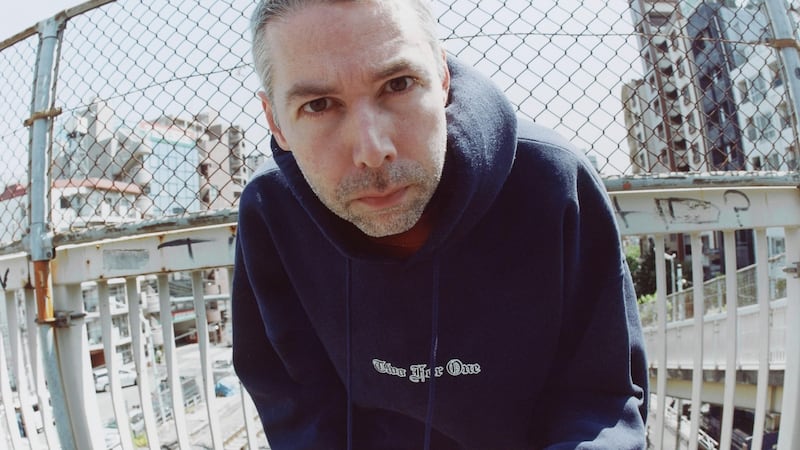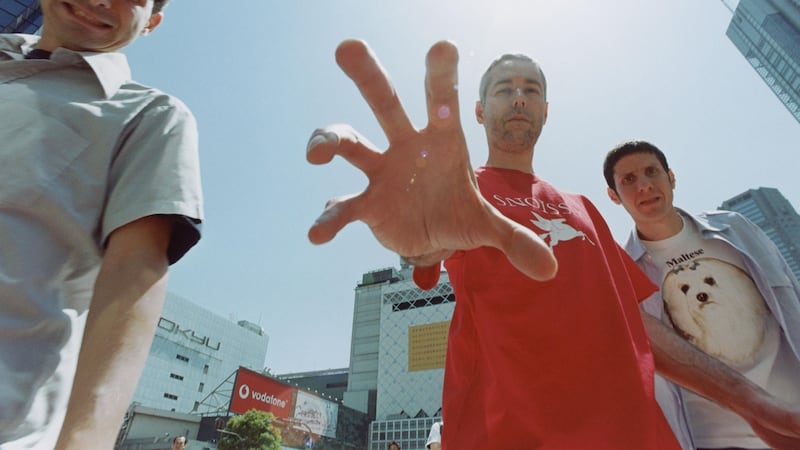“Mike,” says Adam Horovitz, aka Ad-Rock, aka one-third of the Beastie Boys. “Are you drinking something through a straw?”
“Umm … I might have been,” says Michael Diamond, aka Horowitz’s longtime bandmate Mike D.
“You want to remove that thing from in front of the [phone], please?” says Horowitz.
“I thought the steel ones were meant to be silent,” says Diamond.
“We’re trying to have a conversation,’ says Horovitz.
“You know that straws are banned here?” says Diamond, and then his phone reception breaks up.
“All right, well, they’re banning straws,” says Horowitz. “Can you ask your question again? I apologise for Mike, he’s the worst.”
I’m on a conference call with the two surviving members of the Beastie Boys who, throughout the conversation, engage in the sort of deadpan mutual merciless mockery that is only possible between people who have been very good friends for a very long time. It’s 38 years since Diamond met a boy called Adam Yauch at a Bad Brains gig and started what would eventually become the Beastie Boys; Adam Horovitz joined the band in 1983.
Yauch, aka MCA, died of cancer in 2012, but now Horovitz and Diamond have documented their experiences in Beastie Boys Book, a lavishly illustrated and enormously entertaining volume that traces the trio's evolution from hardcore teens in New York to breakthrough rap stars to socially conscious hip-hop legends. Adam Yauch was a big fan of the 1979 Who documentary The Kids Are Alright, and had talked of making a Beasties film in a similar vein. After his death, his bandmates were, Diamond says, just "too sad" to consider taking on the project. "But eventually we felt: okay, it's now or never."

They decided to write a book. “We basically met up and started making a list of things that would be interesting to write about and things that people might want to read about,” says Horovitz. “And then just divvied them up – Mike, you take this; Adam, you take that.” The book’s narrative bounces between their voices – although they each add footnotes to the other’s chapters. “It wasn’t that different to writing lyrics for songs,” says Horowitz. “[In the band] we would just write our own thing and then bounce it off the other … and that’s what we did with the book, too.”
New York’s influence
The book is not a straightforward memoir. One section is a graphic novel. Another is a series of recipes. There are chapters written by other people, including Amy Poehler, the band’s frequent collaborator Spike Jonze, and Kate Schellenbach, the Beasties’ original drummer, who was ousted in 1984 after the boys teamed up with Rick Rubin and Russell Simmons of Def Jam. “When we were thinking about what we thought the book could be like, we thought it would be cool in some way to have it be like our records,” said Horovitz. “We sampled a lot of musicians and so for this book we had guest writers.”
All three Beastie Boys grew up in New York, and the book offers an incredibly vivid picture of what it was like to be a teenager in a scuzzy, brilliantly creative city. They began as a hardcore band (the first time they were all in the same room was a Black Flag gig in 1981), but when downtown Manhattan clubs began to embrace rap, everything changed. “We could only have been [what we became] in New York,” says Diamond. “We could have grown up in the suburbs but the output would have been vastly different.”

Their 1984 single Rock Hard was one of the very first releases from Def Jam Recordings, and in 1985 they supported Madonna on tour. "It felt like being little kids in hotels when we were on those tours, " says Horovitz. "Like playing grown-ups."
Things stepped up a notch in 1986, when Fight For Your Right to Party and the album Licensed to Ill became a massive international hit. The band became the target of British tabloids, and Horovitz briefly ended up in jail in Liverpool after being falsely accused of throwing a can of beer at a fan.
“We were responsible for some of the causation of the first wave of crazy,” says Diamond. “But then with the tabloid stuff and especially with Adam going to jail, it went into this place of [being] totally surreal. It was totally out of control. We were just the vehicle [for people’s fears].
“It could have been us, it could have been the Sex Pistols, it could have been Eminem, Tupac, whoever. Somebody has got to be the person responsible for everything that’s going wrong in the world.”
“It’s like, you know when you put Mentos in a Pepsi bottle?” says Horovitz. “We put the Mentos in the Pepsi bottle but we didn’t know it would really, like, explode.”
LA clubhouse
The band moved on, relocating to Los Angeles and releasing the brilliant (but commercially disappointing) Paul's Boutique in 1989. In 1990 they expanded their horizons when they rented their own studio space in LA, which they named G-Son. It became a base of operations for various projects including their own record label and magazine, both called Grand Royal. Friends from Spike Jonze to Q-Tip from Tribe Called Quest would drop in constantly.

“With G-Son we had this clubhouse, this central meeting place [where we could] just hang out and do whatever we wanted,” says Diamond. “I think that’s why were able to move beyond just making our own music [to] having the label and the magazine and stuff.” Having G-Son also allowed for musical experimentation. “We were very lucky to have the money to rent that space,” says Horovitz. “When you don’t have the money you have to get in the studio and do it as quick as you can because that’s all you can do. So we were very lucky to have the time and the space to just create.”
After the well-received 1992 album Check Your Head, which saw the band playing instruments on record for the first time in years, they had a big hit with 1994's Ill Communication. Their eighth and final album, the excellent Hot Sauce Committee, was released in 2012. Over the years, the band grew up; in the book, Horovitz remembers the moment he realised there were more toddlers in their dressing room than partying adults.
As their lives had changed, how did the band dynamic evolve? “It stayed the same,” says Horovitz. “I mean,” he adds in a perfect deadpan, “Adam and Mike just looked to me as the leader and just gave me the ball and let me do my thing.”
“He was the franchise player,” Diamond says with equal earnestness, referring to the star player around whom American sports teams build their brand. “When you’re in the league a long time you realise you’ve just gotta feed the beast.
“And it’s hard [for me] because I am LeBron James-ish,” says Horovitz. “And I’m working with two Lance Stephensons.”
“Our basketball references are not going to play well in Ireland,” says Diamond, accurately.
Yauch documentary
Beastie Boys Book is possibly the funniest music memoir I've ever read, but it's also, ultimately, one of the most moving. Adam Yauch is not here to tell his story, but his vibrant presence is felt on every page of the book, which is full of stories that highlight his creativity, curiosity, humour and generosity. "It's not as if one story can [sum him up]," says Diamond. "The whole thing with Yauch was what wasn't he interested in, what didn't he figure out, what didn't he try."
So will Yauch’s plan for a Beastie Boys documentary ever see the light of day? “We had started to figure out how to do that and we put it aside because we needed to finish this book,” says Horovitz. “So perhaps one day we might. It would be nice to do that. And there’s also a bunch of music that hasn’t come out yet that we might figure out what to do with.” There’s just one problem, he says. “I just have to figure out how to do it without Mike. I think [his phone has] cut out again so he can’t hear this.”
“All you have to do is sneak in in the middle of night and take that pillow that I’m sleeping on [from] behind my head, and then put it over my face and just hold it for what, two minutes?” says Diamond. “And then there’ll be no more me and you’ve just got it all.”
“Just because I stole a fucking ceiling fan once, now I’m a murderer?” says Horovitz in mock outrage.
“Well, statistically, Adam, when someone has a criminal past…”
MCA may be gone, but Ad-Rock and Mike D are still, forever, Beastie Boys.
HOW BEASTIE BOYS EVOLVED
As far as the band were concerned, their image circa Licensed to Ill was a massive joke about fratboy boorishness, with stage shows featuring girls dancing in cages and, infamously, a giant hydraulic penis. But as Horovitz says in the book, "we got so caught up in making fun of that rock-star persona that we became that persona".
Gradually, however, they became deeply uncomfortable with that image, and started to speak out about sexism – in 1994's Sure Shot, MCA rapped "I want to say a little something that's long overdue / The disrespect of women has got to be through." But perhaps their most pointed critique of misogyny took place at the MTV Awards in 1999, when, while accepting an award, they spoke out about the sexual assaults that had recently taken place at the Woodstock 1999 festival.
“It had just happened and we were live on MTV, so we figured we should say something,” says Horovitz. “And all the bands who had played that thing were going to be there and were watching, so, I figured I should say something.”
“And I think also for us, at that point it was weird going to these awards things,” says Diamond. “We love making music and we love playing music but this is not really what we’re doing it for. So we were like: how do we actually make this useful in some way? How can we be of service?”
“[It] did not play well in the room, I’ll tell you that much,” says Horovitz.
“It was like, ‘Really? Why are you doing that here?’ ” says Diamond. “It wasn’t until afterwards that people were saying ‘Thank you so much, that meant something to me.’ ”

















